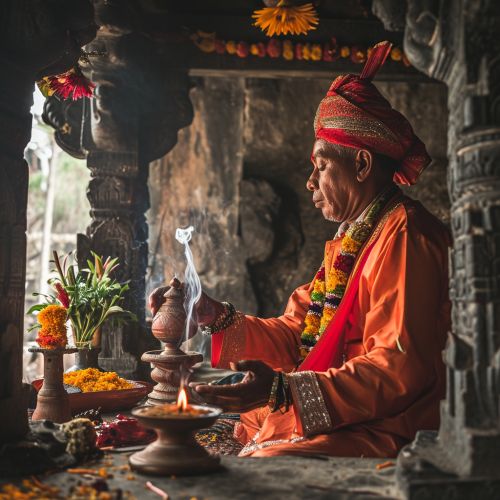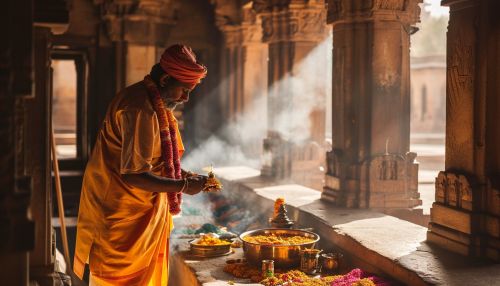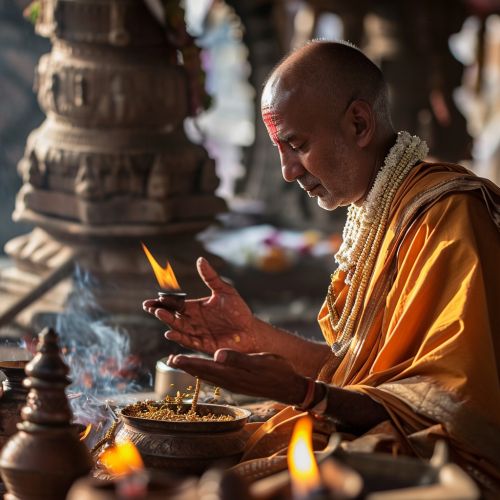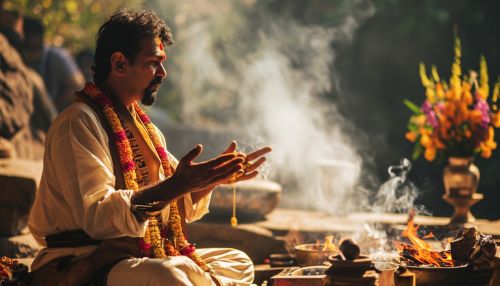Hindu rituals
Introduction
Hindu rituals, also known as Samskaras, are rites of passage that a Hindu individual undergoes from birth to death, marking major milestones and events in an individual's life. These rituals are deeply rooted in the Vedic scriptures and have evolved over thousands of years. They are an integral part of a Hindu's life and are performed with the aim of purifying and sanctifying the individual's existence.


Types of Hindu Rituals
Hindu rituals can broadly be divided into three categories: Nitya (daily), Naimittika (occasional), and Kamya (desired).
Nitya Rituals
Nitya rituals are daily obligations that a Hindu is expected to perform. These include Sandhyavandanam, a prayer to the Sun God at dawn, noon, and dusk; and the five daily Yajnas, which include the Deva Yajna (offering to gods), Pitru Yajna (offering to ancestors), Bhuta Yajna (offering to all creatures), Manushya Yajna (offering to fellow humans), and Brahma Yajna (offering to the Vedas and the sages).
Naimittika Rituals
Naimittika rituals are occasional and are performed on special occasions or during certain seasons. These include the Pancha Mahayajnas, which are five great sacrifices performed during specific times of the year; and the Samskaras, which are sixteen life-cycle rituals that mark significant milestones in a person's life.
Kamya Rituals
Kamya rituals are those performed with a specific desire or goal in mind. These include the Ashvamedha Yajna, a royal ritual performed to establish the king's sovereignty; and the Putrakameshti Yajna, performed to beget a son.
Performance of Hindu Rituals
The performance of Hindu rituals involves a series of steps and requires the involvement of a qualified priest, known as a Purohit. The rituals are performed in accordance with the instructions laid down in the Grihya Sutras, which detail the procedures for domestic rituals.


Preparation
The preparation for a ritual involves the purification of the self and the surroundings. This includes a bath, wearing clean clothes, and cleaning the place where the ritual is to be performed. The ritual items, such as the fire, the offerings, and the utensils, are also prepared and arranged.
Invocation
The invocation is the calling upon of the deity or deities to be worshipped. This is done through the chanting of specific Mantras and the performance of certain gestures, known as Mudras.
Offering
The offering is the presentation of gifts to the deity. These gifts can include flowers, fruits, food, and other items. The offerings are made with devotion and respect, and are accompanied by the chanting of mantras.
Conclusion
The conclusion of the ritual involves the thanking and dismissal of the deity, followed by the distribution of the offerings among the participants. The participants then partake of the Prasad, the blessed food, and express their gratitude for the successful completion of the ritual.
Significance of Hindu Rituals
Hindu rituals hold immense significance in the life of a Hindu. They serve to connect the individual with the divine, purify the self, and promote social harmony. They also serve to uphold the Dharma, the moral and ethical duties that a Hindu is expected to follow.
